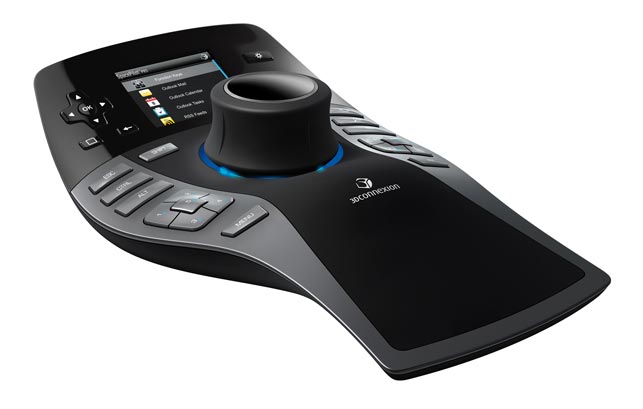3Dconnexion has been developing its range of SpaceMouse products for decades now. These devices enable users to control the 3D model with one hand, while the other hand uses a standard mouse for traditional tasks. The core technology is a cap that provides users with complete, six degrees of freedom, control over how models are panned, zoomed or rotated on screen.
While the lower-end, entry-level products (such as the SpaceMouse Navigator and Traveller) pretty much just provide this capability alone, the higher-end products add a great deal of value on top of that. And with an enhanced range of hot keys and a colour LCD screen, this is where the company’s new SpacePilot Pro fits in.

The colour LCD screen provides context sensitive access to CAD and Office applications
Right side capabilities
The SpacePilot Pro features a number of hot-keys which are located around the 3D control device. To the left is the rotation lock, which effectively turns off model rotation and gives panning priority. This can be surprisingly handy when working with sketches in a 3D context. Below that is axis lock, which is used to lock the rotation of the model to a specific axis.
There are five QuickView navigation keys that provide access to the standard views: top and bottom, right and left, front and back, isometric x 2. Each key has a dual function. For example, a tap on the top button will invoke the ‘top view’ while a longer tap (a hold) will show the bottom view. The fifth button also adds 90-degree view rotation of any view either clockwise or counter-clockwise. Once you get your head round this, it is incredibly useful. Finally, on the left hand side of the unit, is one key that’ll get used more than others: fit. This simply fits everything in session on screen (I bet the print wears off this button first).

The SpacePilot Pro is used in combination with a standard mouse for ultimate 3D control
Hot keys & the LCD
To the left of the device, there is a range of keyboard modifiers: Control, Alt, Shift and Escape. The idea behind this is that because they are used in the vast majority of CAD apps they are located within easy reach. Below this, there is a set of five buttons that are fully integrated with the colour LCD display. This concept was introduced with the SpacePilot, but is greatly extended with the new ‘Pro’ version. It displays a series of context sensitive shortcuts, which change according to the task or mode you’re working in. For example, if you’re working on a part model, there is a different set of shortcuts compared to when you’re working in sketching, draughting or assembly modelling.
While 3Dconnexions has done a fantastic job of late, adding support for almost every 3D modelling or visualisation system currently available on the market, it is worth noting that these context sensitive tools are available for the major systems, which currently include Catia (V5 and V6), Siemens NX, SolidWorks, Inventor, Pro/Engineer, Solid Edge as well as 3ds Max, Maya, Softimage and SketchUp.
The LCD also serves another function, in that it can be configured to interact with Microsoft Outlook (supporting email, tasks and calendar items), RSS feeds to deliver ‘edited’ tips about things going on outside of your CAD application. While the benefit of having a small display feeding your email streams to your left hand might initially seem slightly superfluous, it’s actually quite useful as screen real estate can be reserved for other purposes.
Conclusion
Over the past few years 3Dconnexion has built up a wide range of 3D control devices, from the entry level right up to the higher-end, more sophisticated devices. As an upgrade in the state of the art of these things, the SpacePilot Pro is a supremely impressive device that can serve the power user well. It saves time by providing users with direct control over the manipulation of models, adds direct access to keyboard shortcuts that are used daily and it looks and feels like a high-quality product.
At £399 it’s a costly device, but the productivity gains can certainly justify the investment. However, if budgets are tight, 3Dconnexion offers plenty of other devices that use the same concept for 3D navigation, but without all the bells and whistles. It’s also worth noting that we have a story coming in the next issue of DEVELOP3D that details the development of the device and it’s truly fascinating, so stay tuned.






